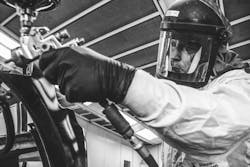It’s always been Barry Hadlock’s dream to run his own multi-shop collision repair operation.
It wasn’t just one location’s fault. When Hadlock stepped back and looked carefully at the company-wide numbers, there was significant waste to be found throughout the entire operation.
Turning around those gross profits hasn’t been easy. But thanks to some inspection process tinkering, diligent tracking of paint department KPIs, and a giant cultural shift that’s improved communication significantly, Hadlock has been able to increase his network of shop’s P&M gross profits by 15 percent. “Over the last 12 months, we’ve spent a lot of time digging into those metrics to figure out what is driving those gross profit dollars, and really getting a good, solid process down to deal with getting the gross profits dollars on the right side,” he says.
The Background
During his 33 years in collision repair, Hadlock has moved from a painter’s helper at the age of 18 to president of Collision Works, which, alongside CEO Jake Nossaman, he has grown from two to six locations in just two years, and is currently working on opening a seventh facility.
Collision Works
Location: Six locations surrounding Oklahoma City
Staff: 97
Average Monthly Car Count: 524
Annual Revenue: $18 million
Adding four locations in two years is thanks to an aggressive growth strategy centered on customer service training, expanding DRPs, an investment in technology and, as Hadlock puts it, “rapid repairs.” Because of it, Collision Works has seen double-digit sales increases two years in a row, including a 16 percent sales increase in 2014.
And while Hadlock is confident in his abilities to nail down procedures for a thorough repair process (he worked on the assembly line as a body technician for years), he’s always looking for some extra guidance. That’s why, after inviting his paint supplier in to do a walkthrough, he and his vendor were able to find exactly what had caused such high P&M costs.
The Problem
There wasn’t just one culprit for low gross profits on P&M. Discovering the solution meant identifying several problems that plagued the paint department.
Hadlock first had to pinpoint why his shops’ costs per paint hour were above the market average, and identify the factors driving up the cost of waste.
EXPERT ADVICE
Five Steps for keeping P&M costs down
Jim Compton, owner and general manager of J. Hunter & Associates, says reducing P&M costs is, ultimately, a team effort. Here are his five steps for making sure you’re keeping costs down long term:
Have standard operating procedures. Establish a set of rules that enable you to have a firm grip on quality and costs. For example, when all work is finished with the same grit as it moves from body shop to paint shop, the paint shop can apply the appropriate amount of primer surfacer. Material usage becomes a more defined quantity (two coats vs. four coats). Establishing who is responsible for each procedure and quality control during the repair process helps to eliminate re-work.
Make an authorized stock list. This is can be as simple as having a pre-printed order form. Work with employees, management and your jobber representative to create a list with the understanding that only the products you need on an ongoing basis can be purchased and shipped by the jobber. Anything that is not on this list needs shop management approval. Do they fit into your established SOPs? Do you have a method to analyze and review their impact of quality and production? Sometimes this analysis is a matter of perception and opinion, but shouldn’t you make changes for the right reasons? If a product claims to offer savings, great measure before and after and see.
Train your employees. Reinforcing that employees are part of the solution and not merely a part of the problem is a great start. We have found that the employee training stops with certain level of employees. Even though the "lessor" tasks performed by “helpers” or other entry level employees can have a big impact on material usage and quality.
Ensure ongoing management involvement. If all levels of shop management are not involved and committed to the process, the results will suffer. As a manager walks through the shop, they can comment on a particular process with employees and reinforce the commitment to P&M cost control. We have found that most employees want to win; they want the approval of their boss.
Measure and share the results. Implementation of P&M cost control requires reports to show if improvements are being made. These are often as simple as jobber purchase reports and trending P&M gross profit percentages. If employees are left in the dark, they will soon fall back into old bad habits or lose sight of the goal. This is the quickest way to slow down the process of P&M cost control.
“One of the things that you really need to look at on a monthly and weekly basis is liquid costs per paint hour,” he says. “That’s the one KPI you can look at that will give you a clear picture quickly on which location is struggling with paint and material costs per hour.”
After performing a cost analysis on how many hours a gallon of sprayable clearcoat produced, he discovered that, in what had originally been an effort to save money, an inexpensive clear coat was actually costing the paint department more in the long run, with each gallon of clear only producing 80 paint hours.
A good portion of the issue boiled down to the inspections and repair process and the lack of communication between body technicians and the paint department.
“Many times, cars would go through reassembly, and then they’d realize there’s another part that needs to be painted,” Hadlock says. “It’s a huge waste of materials and time.”
Because painters were not involved in the repair process until the car came to their department, they were missing out on key information from the body techs. As a result, redos became a significant problem due to improper color matching and poor repair planning.
“Too many times, you get this rush at end of the day and the body man loads up the paint shop and the painter the next morning is just in a mad rush and not really thinking about a car that’s just hit the paint booth. He’s completely unprepared,” Hadlock says. “Being in that rush, you really don’t think about cost savings on materials. Your only thought is, ’How quick can I get this car out of this booth and get the next one in?’”
The Solution
Revamping the repair process by including the painters in the inspection and blueprinting process has eliminated any confusion once the vehicle reaches the paint department.
“It’s really made a big difference in gross profit dollars by doing your spray-out and color matching in the disassembly stage of the vehicle,” he says. “By slowing that process down and getting all that information up front during blueprinting, it allows the painter enough time to plan for the job and figure out how much materials he needs and enough time to do appropriate color matching on for car.
” In a further effort to increase communication between the body and paint department, Hadlock introduced glass markers to the blueprinting process.
“If two parts off the car are expected to be painted separate from the vehicle, then they will write ‘+2’ on the car,” he says. “That could be a gas lid door that’s been removed, a door handle, the side molding. It gives the painter an exact idea of how many parts he has to paint."
To raise awareness about how much waste was occurring in the paint department, Hadlock implemented a materials bonus for his painters. If a shop achieves a paint and materials gross profit of at least 40 percent, he splits half of the profits with the paint team.
Hadlock also decided to spend more on a top-of-the-line clear coat, and after a week of documenting every ounce he found that it produced 150 paint hours per gallon of sprayable clear, versus the 80 hours for the less expensive product.
“There was a huge disparity in cost savings,” he says. “Certainly that gallon of clear coat was cheaper, but that doesn’t mean you’re going to get the sprayable costs per hour where it needs to be.”
The Aftermath
Across all six shops, P&M gross profits rose 15 percent within one year. By the second quarter of 2015, the shops’ combined for a 35.6 percent P&M gross profit, which included liquid, non-liquid and body shop materials. By the fourth quarter, those gross profits rose to 42.2 percent.
Hadlock says the bonus plan has motivated his painters to carefully track their P&M waste.
“These guys manage materials for the entire shop,” he says. “It’s a big cause for change. You don’t walk in and see large amounts of materials on carts. Everything became very organized and neat.”
These days, Hadlock says the painters are continuously searching for new ways of reducing waste, including a recent conversion to 3M’s paint preparation system (PPS) cups.
“We were going with less expensive cups, and the major difference we noticed was the strainer that keeps trash in the paint out of the gun,” he says. “There are cost savings when looking at hazardous waste and the quality of air in the environment.
“We now look for the amount of primer left in a PPS cup. At the end of the day, if you’ve got a lot of hardened up mixed primer sitting around, you might not be mixing appropriate ounces of sprayable material."
Redos have been virtually eliminated, which has aided in reducing average cycle times from 8.9 days in the first half of 2015 to 7.6 days in the fourth quarter, and helped average monthly CSI scores jump from between 85 and 90 percent to consistently resting near 100 percent.
The Takeaway
Stepping back and allowing his paint supplier to observe the repair process allowed Hadlock to notice the minor flaws that were adding significant costs and increase his gross profits.
“I would encourage everyone to take advantage of the resources your paint company has provided for you,” he says. “Invite guys in to do an analysis and dig into any wasted steps and processes. It makes a huge difference.”

